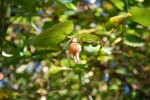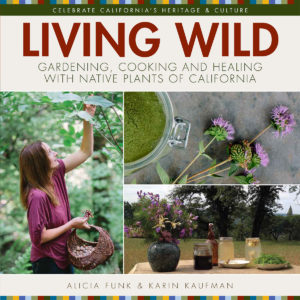Fall Tips for Native Gardening

Beaked Hazelnut (Corylus cornuta)
As summer transitions to fall, it is time to enjoy good weather and cooler nights. Fall is “spring” in our Mediterranean climate means that native plants, stimulated by rain, begin a new cycle of growth after their dormancy in summer. The very best time for planting natives is in the fall after the first heavy rain. The soil retains enough warmth to encourage root growth before the cold of winter, providing a foundation for the top growth that will flourish when the weather warms again.
Things to do in the native garden while waiting for the first fall rain:
- Observe your plants in the garden and containers and continue to water those that need it.
- Collect seeds that you want to preserve.
- Plan any changes you want to make later in the season, such as adding and moving plants. Research the size and cultural requirements of each plant that you will put in your garden. Plan space for the mature size rather than hope to control the plant’s size by pruning.
- Buy native plants at plant sales and your local nurseries. See Living Wild for a list of native plant nurseries.
- Buy wildflower seeds that are appropriate for your area. As the weather cools, water to encourage weeds to germinate in the area you plan for wildflowers.
- Leave annual wildflowers in place for birds to enjoy the seeds. If you feel the need to tidy the yard, remove the spent plants but place them on the ground in an area where wildlife might feed.
- Remove weeds before broadcasting your wildflower seeds. You can plant in October, but if the rain doesn’t come, you’ll have to water the seedbed to keep the soil moist.
- Inspect and care for your tools. Sharpen pruning shears and loppers.
- Prune evergreen shrubs, while they are still dormant from summer. Shape to remove dead, diseased and crossing branches, or to let more light into the interior. Use a thinning cut at the base of the branch or cut to a strong fork, but not at the tip of the branch since it will encourage the growth of a tuft of new branching. Do not cut manzanita or ceanothus, which bloom at the tips and have already formed buds for an early spring bloom.
- Sanitize your pruning tools with cotton dipped in alcohol if you cut any diseased or dead wood.
- Wait for winter or just before spring growth to prune deciduous shrubs.
- Deadhead flowering perennials unless the seed heads are decorative. Perennials may be pruned, but avoid cutting into wood below signs of green growth.
- Rake out or cut back cool-season grasses.
- Inspect and renew your mulch. Pull it back from the trunks of plants.
- Let leaves that fall remain under the bushes to provide a natural mulch.
Here are some things to do after the first soaking rain:
- Refer to books and the Internet if in doubt about how to plant natives and any specific requirements. Sources include the California Native Plant Society, the Sunset Western Garden Book, Living Wild and native plant nursery websites, such as Yerba Buena, Las Pilitas, Tree of Life and the Theodore Payne Foundation. Your county Master Gardeners and local chapter of the California Native Plant Society will offer workshops with many helpful tips.
- Plant your plants. Water and mulch. Continue to water if it doesn’t rain.
- Put protection around your new plants. Avoid using nursery fertilizer that encourages nitrogen-rich leaves that deer love, even if the plants are supposed to be deer-resistant.
- Transplant plant volunteers or move plants that need a change in environment.
- Sow wildflower seeds. Watch the new growth appear and identify weeds you should pull. Keep moist.
- Divide perennial plants, including native irises, coral bells and cool-season grasses, if they are becoming crowded.
- Plant native bulbs and cool-season grasses.
- Take hardwood cuttings from shrubs and try some softwood cuttings, although the latter may be more successful in spring.
This blog concludes my cycle of “things-to-do” each season in the native plant garden. I recommend reading Helen Popper’s California Native Gardening, A Month-by-Month Guide (University of California Press, 2012), which is like conversing with a knowledgeable expert who anticipates your questions. Her advice will help you in planning, planting and caring for your garden and her descriptive words and lovely photos are enticing.
-Darlene Ward, dward@cebridge.net




